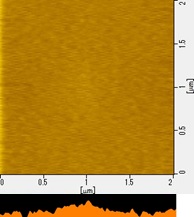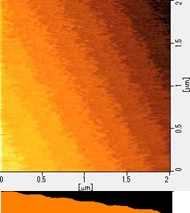In most cases, the grown crystals are processed to suit the application, as they often do not perform their full function as they are. In the case of substrates for thin-film growth, the following processes are used: (1) crystal growth, (2) crystal orienting, (3) slicing, (4) shaping, (5) polishing and (6) cleaning.
The Vickers hardness of SrTiO3 (100) is 455, compared to 1377 for the sapphire c(0001) surface, which is a well-known hard and brittle material, and SrTiO3 crystal is a relatively soft material among oxide crystal materials. When SrTiO3 crystals are machined on equipment that grinds sapphire, they are ground with surprisingly little resistance, to the extent that one is concerned that the sample may be dislodged. While it has good machinability, it is easy to leave strain near the surface when machining with brittle fracture, and when high quality polished surface is required, it is necessary to take measures to avoid leaving the strain during machining.
Even when the strain is removed as much as possible and precision polishing is carried out, the polished surface usually has a small corrugation as shown in the AFM image of the as-polished surface below. When epitaxial thin films are grown on this polished surface, variations in the substrate-film interface and initial film quality are generated. One solution to this problem is the use of “STEP substrates“, where the polished surface is treated by wet etching, annealing or a combination of both to create a “step-and-terrace” structure on the surface. It has been reported that epitaxial thin-film growth using these substrates enables layer-by-layer deposition from the first layer.1) The film quality at the substrate-film interface and in the initial phase of deposition has been dramatically improved. SrTiO3 substrates have been particularly essential for basic research on perovskite-based oxide crystal thin films, as a top surface terminated with a TiO2 layer can be stably obtained by wet-etching STEP treatment.
It is said that to obtain a STEP surface, various conditions such as crystallinity, tilt angle and surface energy as well as crystal structure and properties must be met, and although there are not many materials and surface orientations that can be obtained stably, SrTiO3(100) STEP substrates using wet etching are now available as well as various STEP substrates with guaranteed step-and-terrace surfaces are commercially available.
1) M. Kawasaki et al.: Science 266, 1540 (1994)


(A) as-polished surface (B) after STEP treated surface
Single crystal substrates are like making a substrate from a gemstone, and although they are artificial crystals, they are still expensive. When used in laboratory-scale thin-film growth experiments, it is often sufficient to use substrates with a size that can be used to obtain X-ray diffraction intensity, and substrates with a size of 5 mm square are often used. However, polishing substrates as small as 5 mm square tend to reduce the quality of the polishing process, which is not desirable, and additional processes such as forming are required, which tends to be relatively expensive. For this reason, substrates that have been polished in a larger size may be divided into smaller pieces before use, but in some environments, sufficient processing facilities are often not available. In such cases, “Breakable substrates” are useful. Breakable substrates are ruled grooves on the reverse side using dicing-saw, allowing the substrate to be broken along the grooves like a chocolate bar, making it easy to split and use in laboratories without cutting equipment. It is also useful from the perspective of comparison and evaluation, as multiple samples can be easily produced from the same individual substrate after deposition.
Video of the “Breakable substrate”